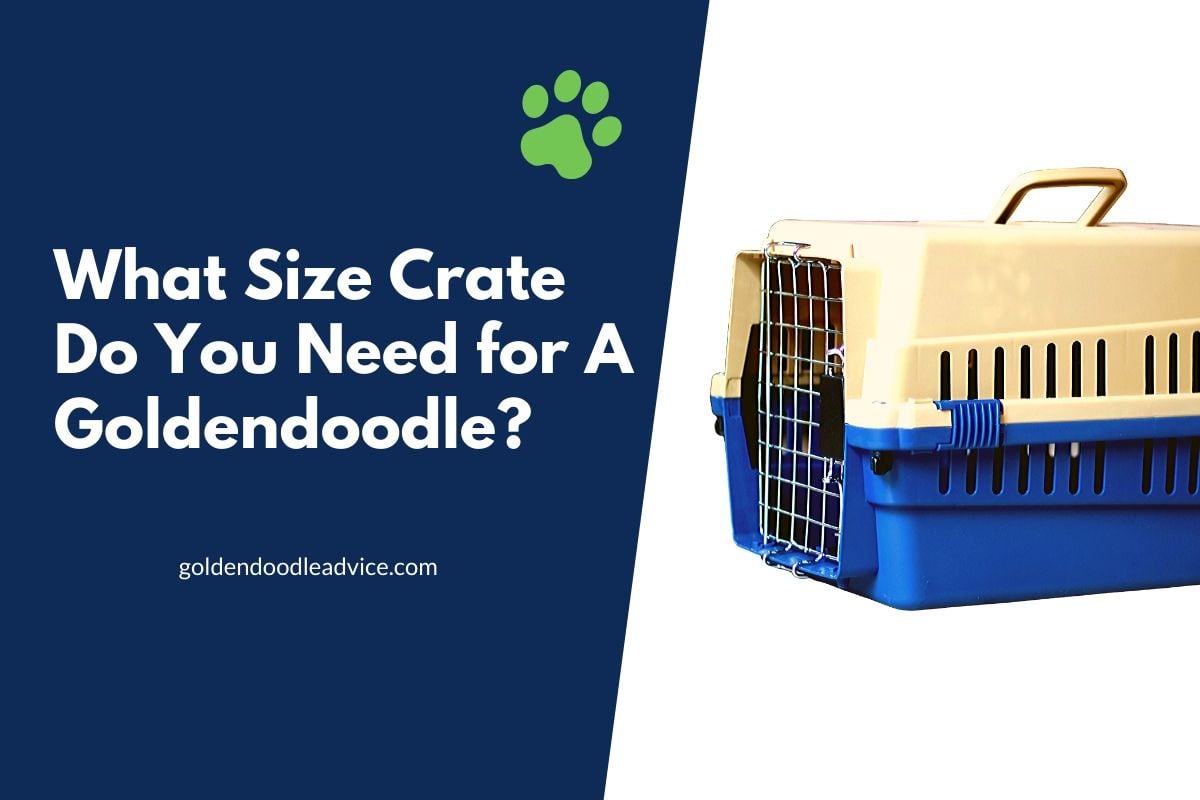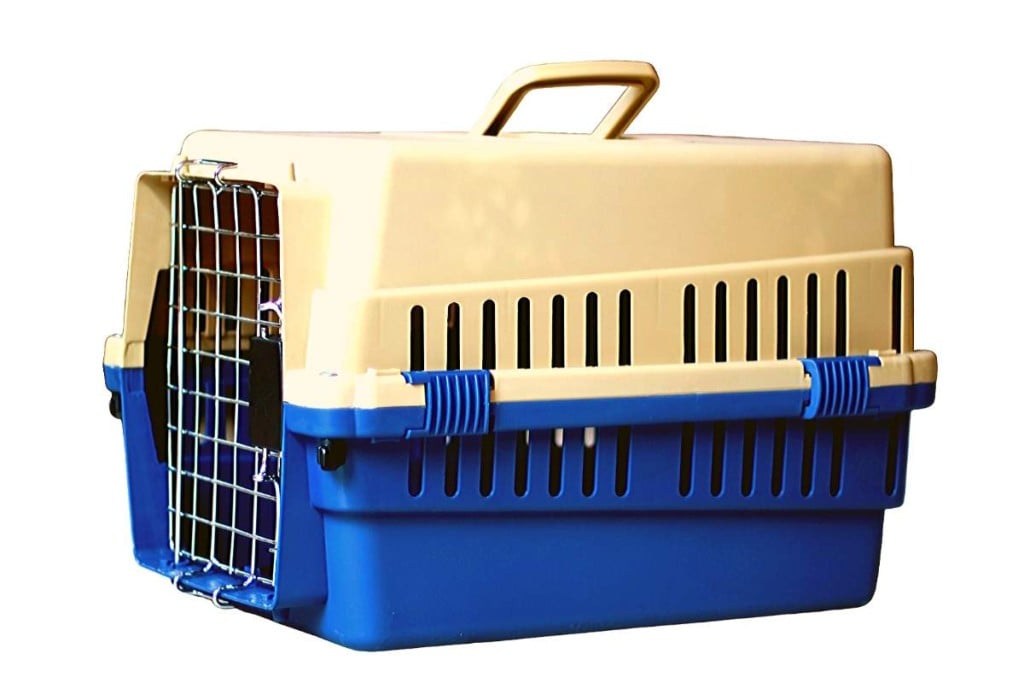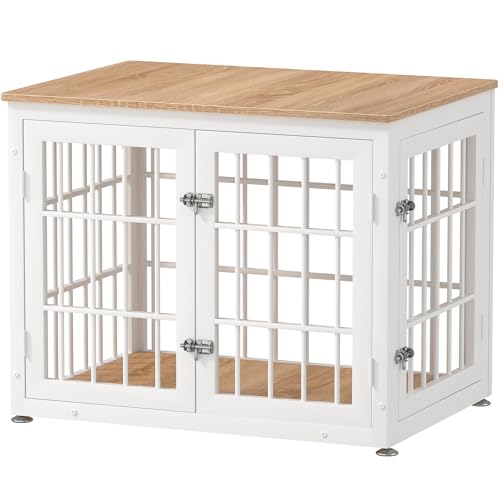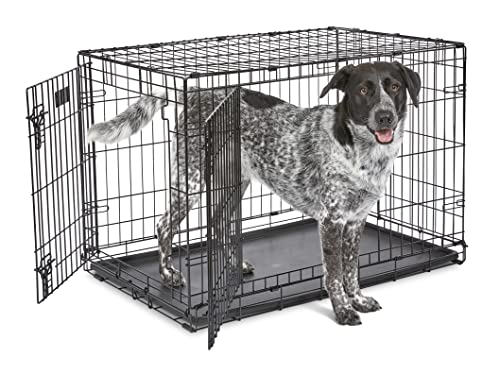What Size Crate Do You Need for a Goldendoodle?
This article is about what size crate you need for a Goldendoodle. Keep reading to learn more.
Goldendoodles are one of the most intelligent, social, and energetic mixed dog breeds out there. Because they come from a Golden Retriever and a Poodle, they get the best (and worst?) traits from each breed. Because of this, you may be looking into crate training your Goldendoodle. Getting a crate of the correct size for your Goldendoodle is super important, so if you’re wondering, “What size crate do I need for my Goldendoodle?” this article has the answers you’re looking for (no matter if you have a mini Goldendoodle or a standard Goldendoodle you’re looking to crate).

What Size Crate Do You Need for a Goldendoodle?
So, what size crate do you need for a Goldendoodle? Generally, a Goldendoodle will need a crate between 36 and 48 inches. The right crate size will depend on the size of your Goldendoodle. Even if you pick the correct crate, you will still need to crate-train your Goldendoodle.
The handy table below outlines the standard measurements of each type of Goldendoodle, as well as what the best crate size is for each one.
Goldendoodle Crate Size Chart
| Height | Weight | Crate Size | |
| Miniature Goldendoodle | 13 to 20 inches | 15 to 35 pounds | 36-inch (Medium) |
| Standard Goldendoodle | 17 to 20 inches | 20 to 40 pounds | 42-inch (Large) |
| Large Goldendoodle | 20 to 40 inches | 50 to 90 pounds | 42-inch (Large) OR 48-inch (XL) |
Although those are the standard guidelines of what crate size each type of Goldendoodle will need, there are a lot of other factors to consider when it comes to determining the correct size of a Goldendoodle–crate training your fur baby.
These include the benefits of crate training, when — and when not — to crate, more specific size suggestions, the types of crates out there, our top crate recommendations, and what other products you may need to go along with your new crate.

Goldendoodle Sizes: Crate Size Suggestions
Although we gave you some size recommendations at the beginning of the article, there are some more surefire ways to determine an ideal crate size for your Goldendoodle. Because they are a mixed breed, their sizes can vary greatly. Plus, if you have a puppy, it can sometimes be challenging to determine what size they will need.
To determine the ideal crate size for your Goldendoodle, you will need to measure your dog in two different ways.
To determine the ideal crate height, measure your dog from the top of his or her head to the bottom of their paws while they are sitting. Then, add four inches to that.
To get the ideal crate length, measure your dog from the base of his or her tail to the tip of their nose. Then, add four inches to that.
These measurements should give you the best crate size for your pup. You will want a size that is just right — not too big and not too small. Ideally, it should be large enough that your Doodle won’t hit their head in any position, can lay on their side with their paws stretched out, and can stand up and turn around all the way.
On the other hand, you don’t want a crate that is too big for them. This may cause them to simply do their business at one end of the crate so that they can peacefully sleep on the other end.
If your crate will be the right size for your Goldendoodle when they are fully grown but is too big as a puppy, you can purchase crate dividers. Many crates come with these when you purchase them, too.
My two daughters and my Goldendoodle all use this same
Types of Crates
There are four different crate types that you can choose from wire, wood, plastic, or cloth. There are benefits and disadvantages to each one, so be sure to read through this to decide which type(s) will be best for your Goldendoodle!
Wire Crates
Wire crates, like this crate, are the most common type and are generally what most people recommend.
They come in a variety of options, such as single-door or multiple-door (I use the multiple-door version). They are generally foldable, which makes them easy to store or travel with.
Another benefit of wire crates is that they have a removable plastic tray at the bottom of them, which makes clean-up incredibly simple. Plus, they allow for a lot of airflow and visibility to keep your dog safe and secure. However, you can always cover the crate with something like this if your dog needs to feel even more secure.
Plus, most wire crates have divider options to resize them as your Goldendoodle grows.
One of the downsides to wire crates is that they are easy to escape from if your dog is particularly deviant. They can also be quite noisy if your dog moves around a lot.
Wooden Crates
Wooden crates are quite popular among people who want their crate to go along with their home decor — and for good reason! They are gorgeous, especially in a farmhouse-style home. The best part is that they can serve a dual purpose as a side table or piece of furniture.
Another benefit of wooden crates is that they aren’t as easy to escape from. However, wooden crates have numerous drawbacks that you should keep in mind.
First, these are typically going to be the most expensive option out of all the crate choices. They are also easy to damage if your Goldendoodle is prone to chewing or scratching.
Last but certainly not least, wooden crates can be challenging to clean. They may also absorb moisture, so if your dog has an accident in one, they may be left with a permanent odor or stain. For this reason, we don’t recommend choosing a wooden crate until your puppy is full-grown and trained.
Plastic Crates
Next up, we have plastic crates, which many consider the best option for travel. They are also airline-friendly.
These crates are excellent for cold climates, as they are sheltered. They are more difficult to escape, lightweight, and easily portable.
However, plastic crates cannot be folded down and do not have much ventilation or visibility. Many people are not a fan of how they look, either. So, we don’t recommend these if you want your crate to double as a piece of decor.
Cloth Crates
Finally, we have cloth crates. These are the lights and most portable option, making them excellent for road or day trips, such as camping. They can also be stored easily.
However, these soft crates are incredibly easy for Goldendoodles to escape from and easily ruined from chewing and scratching. If you choose to get a cloth crate, you can expect to replace it often.
Crate Reviews
Now that you understand the appropriate crate size and what to look for in a crate, here is a list of our top recommendations for crates to purchase for your Goldendoodle.
Basics Single-Door & Double-Door Folding Metal Dog Crate
This Basics dog crate, which can be found here, is a wire crate that will be perfect for your Goldendoodle.
It comes in a variety of size options, so you will be able to find the perfect fit, whether you have a puppy or a fully-grown dog, as well as whether you have a Mini, Standard, or Large Goldendoodle.
This crate has a dual-slide bolt lock that will keep your Goldendoodle safe and secure, as it’s quite challenging for them to escape from. There is also a removable plastic tray at the base of the crate, making for an easy clean-up in case your Doodle has an accident inside.
Another one of the best features of this crate is that it comes with a divider, which is perfect for a growing puppy.
Plus, this crate can easily fold down into a carrier to store it or travel with it.
Although this crate has fairly thin wiring and frames, it will be quite difficult for a Goldendoodle to chew through.
MidWest Homes iCrate
The iCrate, found here, is easily considered one of the best dog crates for Goldendoodles on the market.
This one also comes in a variety of sizes, so it can work for your Goldendoodle no matter what size or age they are.
The iCrate comes with single-door or double-door options, as well as a divider panel that is excellent for growing puppies.
This crate is incredibly secure, as it has slide-bolt latches, rounded corners, and a durable finish. Plus, it easily folds for travel and storage. The iCrate also comes with a removable plastic tray to make for easy clean-up.
However, keep in mind that the latch may be simple for your dog to figure out how to unlatch and escape from the crate. The divider panel is also known to be challenging to put in place and remove.
Crate Accessories To Make It Feel Like Home
Now that you may have a crate purchased, you may need some additional products to give your Goldendoodle the best possible experience with it.
Dog Crate Divider Panels
If you chose a crate that doesn’t come with divider panels, then you may want to purchase some on your own. As we mentioned throughout this article, dividers can be incredibly helpful for making your crate the correct size for your puppy as he or she is growing.
Dog Bed
To make your dog crate as comfortable as possible for your Goldendoodle, you will want to purchase a high quality dog bed to stay inside of it, especially if you crate your dog overnight or for longer periods. Not just for comfort, this can help with their joints long term, too.
While you may be tempted to just use a blanket, dogs are more likely to chew them up. Not only will you be out a blanket, but your dog will have learned a new destructive behavior. Dog beds made from tough fabric will last longer.
This dog bed from MidWest Homes, found here, is the perfect option.
It comes in a variety of size options, so you will be able to find the ideal choice for your fur baby. It is also machine-washable, so you will easily be able to clean it if your pup has an accident in the crate!
The Importance of Crate Training Goldendoodles
There are numerous benefits to crate training your Goldendoodle. All dogs should have space where they can feel safe, rest, and have shelter. A crate is perfect for this!
Your puppy’s crate will act as their bedroom. It gives them somewhere to escape and relax that is entirely their own.
Besides, a crate has multiple purposes that can help better serve both you and your Doodle.
One way that crate training is beneficial is because it can assist with potty training by teaching your Goldendoodle to control their bladder and bowels. By nature, dogs will generally do their best not to soil the space that they sleep in. Because of this, they will want to keep their crate as clean as possible.
Of course, puppies are bound to have an accident here and there. So, make sure that you stay around as often as possible when your puppy is in the crate to clean up after them.
A crate can also provide your Goldendoodle with his or her own “safe space.” Once dogs become accustomed to their crate, they will often wander into it on their own to take a nap or just relax. This is similar to what dogs do out in the wild, looking for a dugout or den.
Finally, a crate can help keep your Doodle’s teething at bay. Goldendoodle puppies tend to chew on various objects as their teeth are growing in. By teaching them to only chew on toys while they are in the crate, you can help teach them that it’s not okay to chew on your personal items, such as shoes.
When You Should Crate
Now you may be wondering, when is the best time to crate train a dog? And what are the guidelines for keeping your dog in the crate while you’re away?
There are many times when it is appropriate to crate your dog, and many of them will improve your dog’s well-being.
One time to keep your dog in their crate is when you are unable to supervise them. For example, if you need to do yard work, you can put your dog in his or her crate while you do so to keep them safe. This way, they will not hurt themselves or destroy your home while you’re away.
Another excellent time to put your Goldendoodle in his or her crate is when they need to calm down from being too excited. Keep in mind, though, that you should not act like this is a punishment. You want to teach your dog to enjoy being in their crate — not be afraid of it.
So, when you are crating your dog for “timeout” purposes, be sure not to accompany it with any anger. Try not to let your anger be a factor at all. Give them a toy to play with for about five minutes to calm them down, and let them out afterward to see if it helps. If not, you can repeat the process until they are calmer.
Traveling is another excellent example of when it’s appropriate to use a crate. A loose dog in the car can be dangerous, so keeping them in the crate can help keep them — and other passengers — safe and calm. It also will limit distractions. For more information about driving with a dog, check out this article from DogTime.com.
Finally, a crate can be beneficial when you’re introducing a puppy to your home while you already have an older dog. Typically, Goldendoodle puppies will be energetic, and this may be overwhelming for an older dog.
Having a crate can give the older dog a break and keep your puppy safe. You can alternate which dog stays in the crate until they are more used to each other.
When You Should Not Crate
Now that you know when to crate your dog, you may be wondering when you shouldn’t crate your dog.
For starters, a general rule of thumb is not to leave your Goldendoodles in their crate for over five hours. The exception to this would be overnight, of course.
There are a few reasons for this. Goldendoodles are an incredibly social breed and need social interaction to stay happy. If they are left in their crate for too long or too frequently, then they may begin to develop behavior issues or even depression. They also shouldn’t be left in their crate for longer than they can hold their bladder.
I know what you might be thinking at this point — what if I have to work all day? In this case, come home for lunch, if at all possible, to let your dog out for a little bit. If that’s just not an option for you, it’s best to have a friend, family member, or pet walker/sitter come over to let your dog out about halfway through the day.
Additionally, it’s not a wise idea to crate your Goldendoodle if he or she suffers from separation anxiety. This will just worsen their condition and make them more stressed out.
If you notice that your dog has broken teeth or chipped claws after being in their crate, that’s another sign that they are experiencing intense anxiety while inside. They are most likely doing everything that they can to escape.
If you see any of this behavior in your Goldendoodle, consult with your vet to find out what your best options are.
You should also refrain from crating your Doodle if the vet tells you not to due to medical reasons, such as inflamed joints or arthritis. It’s also best not to if they are having an excessive amount of accidents in the crate or just because you don’t want to deal with them.
Overall, do your best to make the crate a positive experience for your Goldendoodle. It shouldn’t be a place that your pup doesn’t want to go to or is afraid of.
Here are some additional steps to take before crating your dog to ensure the best possible experience:
And, there you have it. Although you may have some struggles at first getting your Goldendoodle to adapt to a crate, we can almost guarantee that your Goldendoodle will end up getting accustomed to (and maybe even loving!) his or her crate. You just have to give it time and lots of patience (and maybe a few treats). Best of luck!








